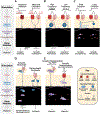The neuronal stimulation-transcription coupling map
- PMID: 31163285
- PMCID: PMC6885097
- DOI: 10.1016/j.conb.2019.05.001
The neuronal stimulation-transcription coupling map
Abstract
Neurons transcribe different genes in response to different extracellular stimuli, and these genes regulate neuronal plasticity. Thus, understanding how different stimuli regulate different stimulus-dependent gene modules would deepen our understanding of plasticity. To systematically dissect the coupling between stimulation and transcription, we propose creating a 'stimulation-transcription coupling map' that describes the transcription response to each possible extracellular stimulus. While we are currently far from having a complete map, recent genomic experiments have begun to facilitate its creation. Here, we describe the current state of the stimulation-transcription coupling map as well as the transcriptional regulation that enables this coupling.
Copyright © 2019 Elsevier Ltd. All rights reserved.
Conflict of interest statement
Conflict of Interest Statement
Nothing declared.
Figures


References
-
- Greenberg ME, Ziff EB, Greene LA: Stimulation of Neuronal Acetylcholine Receptors Induces Rapid Gene Transcription. Science 1986, 234:80–83. - PubMed
-
- Douglas RM, Dragunow M, Robertson HA: High-frequency discharge of dentate granule cells, but not long-term potentiation, induces c-fos protein. Mol Brain Res 1988, 4:259–262. - PubMed
-
- Sheng HZ, Fields RD, Nelson PG: Specific Regulation of Immediate Early Genes by Patterned Neuronal Activity. J Neurosci Res 1993, 35:459–467. - PubMed
-
**This study was the first to test how different temporal patterns of neuronal activity affect gene expression. They found that transcription of Fos increases with increasing frequency.
-
- Sheng HZ, Lin PX, Nelson PG: Combinatorial expression of immediate early genes to single neurons. Mol Brain Res 1995, 30:196–202. - PubMed
Publication types
MeSH terms
Grants and funding
LinkOut - more resources
Full Text Sources

